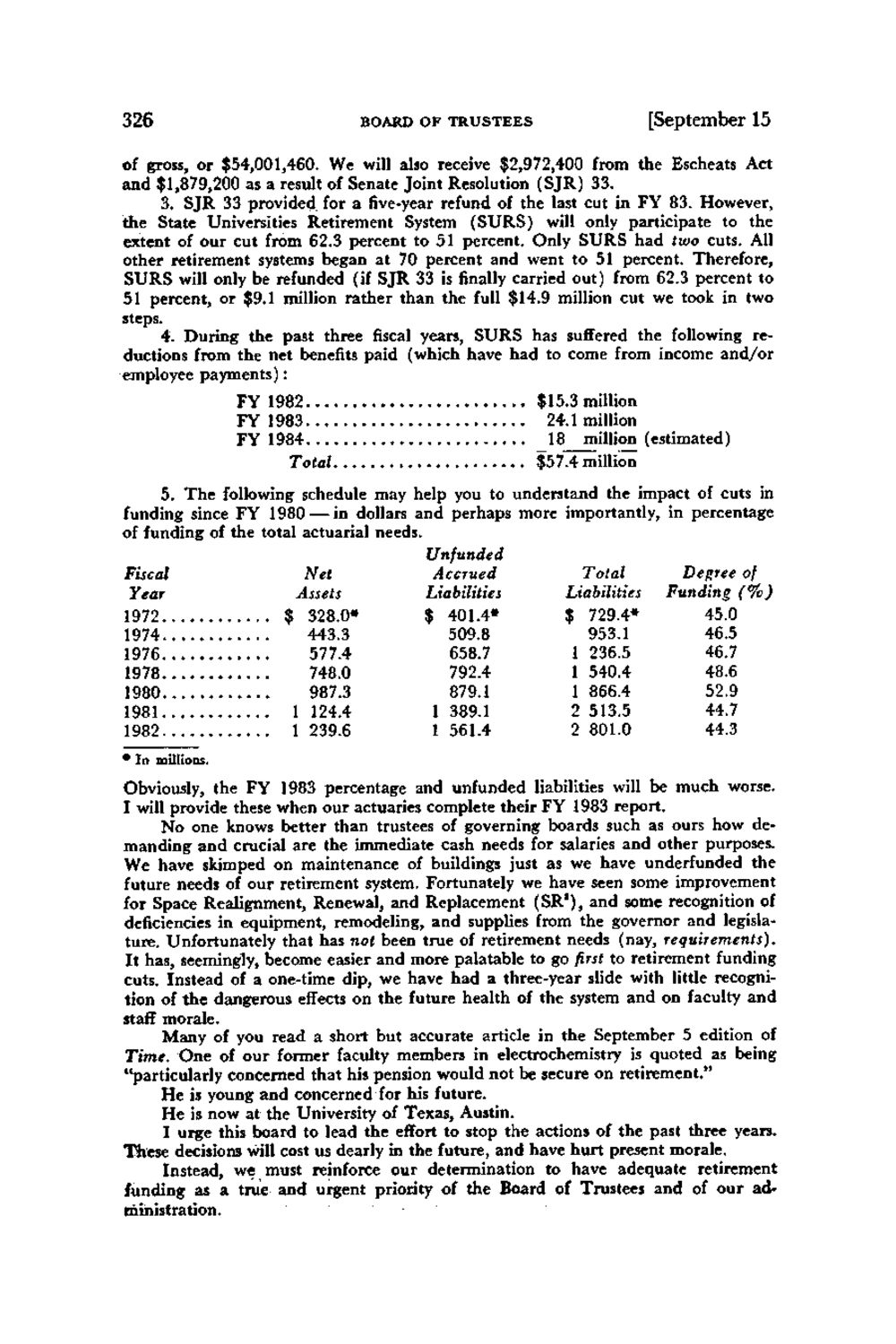| |
| |
Caption: Board of Trustees Minutes - 1984
This is a reduced-resolution page image for fast online browsing.

EXTRACTED TEXT FROM PAGE:
326 BOARD OF TRUSTEES [September 15 of gross, or $54,001,460. We will also receive $2,972,400 from the Escheats Act and $1,879,200 as a result of Senate Joint Resolution (SJR) 33. 3. SJR 33 provided for a five-year refund of the last cut in FY 83. However, the State Universities Retirement System (SURS) will only participate to the extent of our cut from 62.3 percent to 51 percent. Only SURS had two cuts. All other retirement systems began at 70 percent and went to 51 percent. Therefore, SURS will only be refunded (if SJR 33 is finally carried out) from 62.3 percent to 51 percent, or $9.1 million rather than the full $14.9 million cut we took in two steps. 4. During the past three fiscal years, SURS has suffered the following reductions from the net benefits paid (which have had to come from income a n d / o r employee payments): FY 1982 FY 1983 FY 1984 Total $15.3 24.1 18 $57.4 million million million (estimated) million 5. T h e following schedule may help you to understand the impact of cuts in funding since FY 1980 — in dollars and perhaps more importantly, in percentage of funding of the total actuarial needs. Unfunded Total Degree of Fiscal Net Accrued Year Assets Liabilities Liabilities Funding (%) 45.0 $ 729.4* 1972 $ 328.0* $ 401.4* 953.1 46.5 1974 443.3 509.8 1 236.5 46.7 1976 577.4 658.7 1 540.4 48.6 1978 748.0 792.4 1 866.4 52.9 1980 987.3 879.1 2 513.5 44.7 1981 1 124.4 1 389.1 2 801.0 44.3 1982 1 239.6 1 561.4 ' In millions. Obviously, the FY 1983 percentage and unfunded liabilities will be much worse. I will provide these when our actuaries complete their FY 1983 report. No one knows better than trustees of governing boards such as ours how demanding and crucial are the immediate cash needs for salaries and other purposes. We have skimped on maintenance of buildings just as we have underfunded the future needs of our retirement system. Fortunately we have seen some improvement for Space Realignment, Renewal, and Replacement (SR S ), and some recognition of deficiencies in equipment, remodeling, and supplies from the governor and legislature. Unfortunately that has not been true of retirement needs (nay, requirements). It has, seemingly, become easier and more palatable to go first to retirement funding cuts. Instead of a one-time dip, we have had a three-year slide with little recognition of t h e dangerous effects on the future health of the system and on faculty and staff morale. Many of you read a short but accurate article in the September 5 edition of Time. One of our former faculty members in electrochemistry is quoted as being "particularly concerned that his pension would not be secure on retirement." He is young and concerned for his future. H e is now at the University of Texas, Austin. I urge this board to lead the effort to stop the actions of the past three years. These decisions will cost us dearly in the future, and have hurt present morale. Instead, we must reinforce our determination to have adequate retirement funding as a true and urgent priority of the Board of Trustees and of our administration.
| |